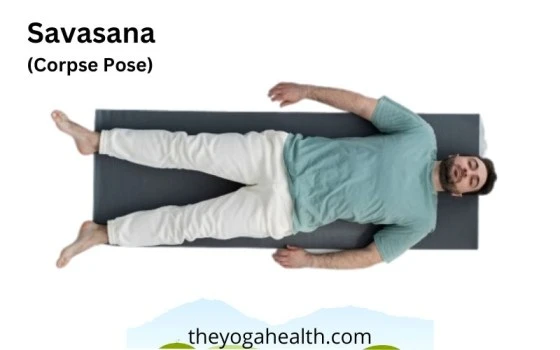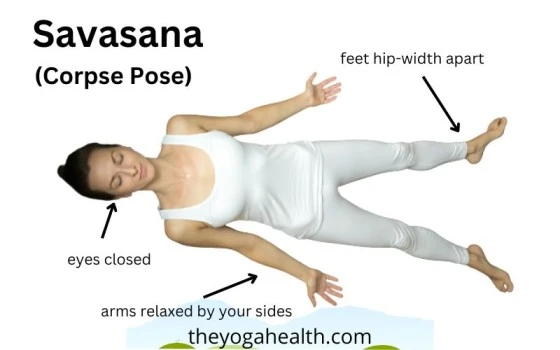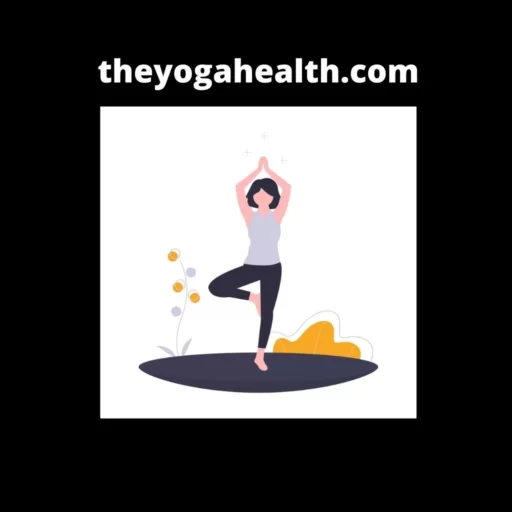Welcome to the world of Savasana (Corpse Pose), a pose that brings ultimate relaxation and rejuvenation to both the mind and body. In this comprehensive article, we will delve into the meaning, history, benefits, variations, and safety precautions of this pose.
Whether you are a beginner or an experienced yoga practitioner, this article will help you with all the information you need to fully grasp the details of this pose and reap its full benefits.
Table of Contents
Understanding Savasana (Corpse Pose)
Savasana, also known as the Corpse Pose, is a reclined posture practiced at the end of a yoga session. This position can help practitioners achieve deep relaxation and integration as it acts as a link between the material and spiritual realms of yoga. The name “Savasana” comes from the Sanskrit words “Sava” meaning “corpse” and “Asana” meaning “pose.”
Basic Details:
| Sanskrit Name | Savasana |
| English Name | Corpse Pose |
| Difficulty Level | Beginner |
| Position | Supine |
Meaning of Savasana
This asana holds profound symbolism within the yogic tradition. It symbolizes the change from life to death, serving as a reminder to yoga practitioners of the necessity of letting go. Historically, this pose has been practiced for centuries as a means to achieve complete relaxation and inner stillness.
Savasana Benefits
This asana, offers a myriad of benefits that contribute to deep relaxation and overall well-being. Let’s explore these benefits in detail:
- Deep Relaxation: It induces a state of deep relaxation by allowing your body and mind to release tension and stress accumulated throughout the day. It promotes a sense of calmness.
- Stress Reduction: Practicing this pose regularly can help reduce stress levels. By consciously letting go and surrendering to the present moment, you create space for mental and emotional rejuvenation.
- Improved Sleep Quality: It is an excellent tool for improving sleep quality. The practice of deep relaxation prepares your body and mind for restful sleep, helping you fall asleep faster and experience more restorative rest.
- Enhanced Focus and Mental Clarity: It provides a valuable opportunity to quiet the mind and cultivate mental clarity. When you let go of the running thoughts and worries, you can improve your ability to concentrate and focus on the present tasks at hand.
- Reduced Anxiety and Depression: The relaxation response triggered by this pose can help alleviate symptoms of anxiety and depression. It promotes a sense of inner peace, uplifts mood, and cultivates a positive mind set.
- Muscle Relaxation: During this pose, your muscles have a chance to fully relax, allowing for tension to dissolve. This can help relieve muscle soreness, tightness, and promote a greater sense of physical ease.
- Improved Circulation: The reclined position of this pose facilitates healthy blood flow throughout the body. This helps improve circulation, delivering vital oxygen and nutrients to the cells, and supporting overall cardiovascular health.
- Regulation of Blood Pressure: Regular practice of this asana has been found to help regulate blood pressure. By promoting healthy blood flow and lowering high blood pressure, it can minimize the risk of cardiovascular issues.
- Enhanced Mind-Body Connection: It strengthens the mind-body connection by creating a space for introspection and self-awareness. It provides a spiritual approach to self-care and self-discovery by taking care of a person’s physical, mental, and emotional health.
- Overall Well-Being: The cumulative effect of practicing this asana contributes to overall well-being. It enables you to become aware of the sensations, feelings, and needs of your body.
This Pose offers a plethora of benefits for the mind, body, and soul. You can benefit from this meditation stance in terms of better stress management, increased focus, decreased anxiety, better sleep, and general physical well-being.
How to do savasana pose
To fully embrace the art of this asana, follow these steps:
- Find a quiet and peaceful space where you can lie down comfortably on your back.
- Keep your legs extended, feet hip-width apart, and arms relaxed by your sides.
- Allow your body to sink into the floor as you close your eyes and take slow, deep breaths.
- Bring your awareness to each part of your body, consciously releasing tension as you go.
- Focus on your breath, allowing it to flow naturally without any force or control.
- Stay in this relaxed condition for 10 to 20 minutes, or whatever long you choose.
- When you’re ready to conclude your practice, gently awaken your body by wiggling your fingers and toes.
Common Mistakes to Avoid
While this posture may appear straightforward, there are a few frequent errors to watch out for:
- Falling asleep: Attempt to retain a relaxed awareness even though it is common to feel tired.
- Tension in the body: Be mindful of any residual tension and consciously release it as you progress through the pose.
- Restlessness: If your mind starts to wander, gently bring your attention back to your breath and the present moment.
Modifications and Variations
This asana can be modified to suit individual needs and preferences. Here are a few variations of you can explore:
- Support under the knees: Place a bolster or folded blanket under your knees to relieve lower back discomfort.
- Eye pillow: Cover your eyes with a soft eye pillow to create a soothing and peaceful environment.
- Blanket for warmth: Use a cozy blanket to keep your body comfortably warm during the relaxation process.
Safety Precautions for a Blissful Experience
To ensure a safe and enjoyable practice, consider the following precautions:
- Consult a healthcare professional: If you have any underlying medical conditions, seek guidance before starting a new yoga practice.
- Support for the neck: If you experience discomfort in the neck area, use a folded blanket or towel for added support.
- Pregnancy: Modify the pose by elevating the upper body with a bolster or placing a pillow under the right hip to avoid compression of blood vessels.
Addressing Contradictions
While Savasana is generally safe for most individuals, there are a few contradictions to be mindful of:
- Low blood pressure: If you have low blood pressure, it is advisable to rise slowly from the asana to prevent dizziness.
- Recent surgery: If you’ve undergone surgery, consult your healthcare provider before engaging in deep relaxation practices.
Recommended Follow-Up Poses to Enhance Your Practice
After indulging in the tranquillity of this asana, consider incorporating these follow-up poses into your yoga routine:
- Child’s Pose (Balasana): Offers gentle stretching and grounding.
- Seated Forward Bend (Paschimottanasana): Relieves tension in the lower back and hamstrings.
- Easy Pose (Sukhasana): Promotes a calm and meditative state.
The Art of Breathing
During this pose, focus on cultivating deep and conscious breathing. Allow your breath to flow naturally, without any effort or control. Completely submit to the rhythm of your breath by sensing the expansion and contraction of your belly and chest with each inhalation and exhalation. This mindful breathing practice enhances relaxation and helps quiet the mind.
Real Experiences: Stories from Yoga Practitioners
This asana has touched the lives of countless individuals, offering them profound experiences of tranquility and self-discovery. Here are a few testimonials from people who have embraced the power of this pose:
“Corpse Pose has become my sanctuary. It helps me release stress and find inner peace like nothing else.” George from Texas
“The deep relaxation I experience in Corpse Pose has improved my sleep quality and overall well-being.” Samantha Lynch from Georgia
“I never realized how transformative Corpse Pose could be until I made it a regular part of my yoga practice. It has brought me a newfound sense of calm and clarity.” Aarti Goyal from India.
Conclusion for Savasana:
Savasana (Corpse Pose) is not just a pose; it is an invitation to enter a state of deep relaxation and connection. You can get significant physical, mental, and spiritual advantages by embracing the calmness of this pose and including it frequently in your yoga practice.
So, lay down your worries, surrender to the present moment, and allow the transformative power of this asana to envelop you in its soothing embrace.
FAQs: Savasana (Corpse Pose)
1. What is Corpse Pose ?
Ans. This asana is a yoga pose that is often called the Corpse Pose. You can release tension in your body and mind by lying down on your back in this soothing position.
2. What does Corpse Pose mean?
Ans. The word “Savasana” comes from Sanskrit, with “Sava” meaning “corpse” and “Asana” meaning “pose.” It represents the idea of letting go and surrendering, similar to how a corpse lies peacefully.
3. What are the benefits of Corpse Pose ?
Ans. Deep relaxation, stress reduction, enhanced attention, better sleep, less anxiety, muscle relaxation, improved circulation, and general well-being are just a few advantages of this pose.
4. How do I do Corpse Pose ?
Ans. Find a calm area and lie on your back to practice. Keep your arms at your sides, relaxed, and with your palms facing up. Put your eyes closed, take a few deep breaths, and relax your entire body. Stay in this position for a few minutes to fully relax.
5. What mistakes should I avoid during Corpse Pose ?
Ans. Some common mistakes to avoid in this pose include falling asleep completely, holding tension in your body, and letting your mind wander. Try to maintain a state of relaxed awareness, consciously release tension, and gently bring your focus back to your breath and the present moment.
6. Can I modify Corpse Pose to suit my needs?
Ans. Yes, you can make modifications to enhance your comfort during this pose. You can use props like blankets or bolsters to support your body, place an eye pillow over your eyes for a soothing experience, or cover yourself with a blanket for warmth.
7. Are there any safety precautions for Corpse Pose ?
Ans. While this asana is generally safe, it’s important to consider a few precautions. Before beginning a new yoga practice, speak with a medical professional if you have any health issues.
If you feel discomfort in your neck, use a folded blanket or towel for support. Pregnant individuals should modify the pose to ensure comfort and safety.
8. Are there any contradictions to practicing Corpse Pose ?
Ans. Although this pose is generally safe, individuals with low blood pressure should rise slowly from the pose to prevent dizziness.
Those who have recently had surgery should consult their healthcare provider before engaging in deep relaxation practices.
9. What poses can I do after Corpse Pose ?
Ans. After this pose, you can try gentle poses like Child’s Pose, Seated Forward Bend, or Easy Pose to further relax and ground yourself.
10. How does Corpse Pose affect my breathing?
Ans. During this asana, focus on deep, natural breathing. Allow your breath to flow without forcing it. This mindful breathing practice enhances relaxation, quiets the mind, and promotes overall well-being.
Do share your experience of doing this Pose and if You have any question or comments regarding this Pose, you can mention so in the comments section below.







